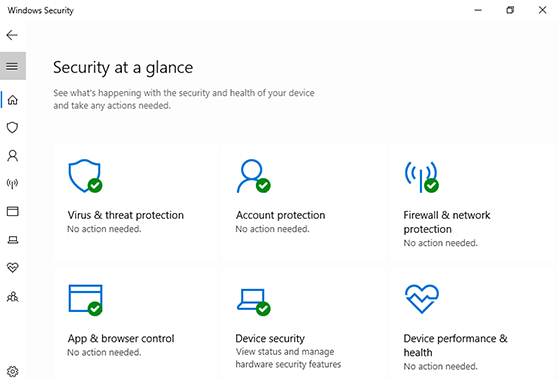
Getting Started with Windows Security and Windows Defender
Introduction to Windows Security and Windows Defender
Included with the default installaton of Windows 10 is Windows Security, which includes a robust and efficient antivirus protection system called Microsoft Defender. The Windows Defender application continuously monitors in real-time for malware, viruses, and other security threats on your Windows 10 desktop computer, laptop or tablet. In addition to this real-time protection, updates are downloaded automatically to help keep your desktop computer, laptop or tablet safe and protect it from these threats.

Windows Security GUI
Brief overview of the Windows Security features
Windows Security offers the following features to help keep your desktop computer, laptop or tabet safe from malicous activities:
- Virus & threat protection. Monitors threats to your desktop computer, laptop or tablet, run scans, and is regularly updated to help detect the latest threats.
- Account protection. Access sign-in options and account settings.
- Firewall & network protection. Manages the local firewall settings and monitors what’s happening with your networks and internet connections.
- App & browser control. Update settings for Microsoft Defender SmartScreen to help protect your desktop computer, laptop or tablet against potentially dangerous apps, files, sites, and downloads. You'll have exploit protection and you can customize protection settings for your devices.
- Device security. Review built-in security options to help protect your desktop computer, laptop or tablet from attacks by malicious software.
- Device performance & health. View status info about the performance health of your desktop computer, laptop or tablet and keep it clean and up to date with the latest version of Windows 10.
- Family options. Keep track of your kids’ online activity and the desktop computers, laptops or tablets in your household.
Status icons indicate your level of safety:
- Green means your device is sufficiently protected and there aren’t any recommended actions.
- Yellow means there is a safety recommendation for you.
- Red is a warning that something needs your immediate attention.
How do I review the virus and threat protection settings in the Windows Security app?
- Open the Windows Security app by clicking the shield icon in the task bar or searching the Start menu for Defender.
- Click on the Virus & threat protection tile (or the shield icon on the left menu bar).

Windows Security
How do I open Microsoft Defender?
- Click on the Start button.
- Click on Settings.
- Click on Update & Security.
- Click on Windows Security.
- Click on Virus & threat protection.
How do I update the Windows Defender malware and virus defintions?
- Click on the Start button.
- Click on Settings.
- Click on Update & Security.
- Click on Windows Security.
- Click on Virus & threat protection.
- Click on Check for updates under Virus & threat protection updates.
- Click on the Check for updates button.
How do I run a manual scan?
If you have any antivirus or malware concerns about a specific file or folder, you can right-click the file or folder in File Explorer, then select Scan with Microsoft Defender.
If you suspect there is malware or a virus on your desktop computer, laptop or tablet, you should immediately run a quick scan on all your files and folders. To run a quick scan:
- Click on the Start button.
- Click on Settings.
- Click on Update & Security.
- Click on Windows Security.
- Click on Virus & threat protection.
- Click on the Quick scan button.
If you don't find any urgent issues, you may want to check your desktop computer, laptop or tablet more thoroughly.
How to run an advanced scan
- Click on the Start button.
- Click on Settings.
- Click on Update & Security.
- Click on Windows Security.
- Click on Virus & threat protection.
- Click on Scan options.
- Select one of the following scan options:
- Quick scan
- Full scan (this scan will check all files and programs currently running on your device).
- Custom scan (this will only scan specific files or folders).
- Microsoft Defender Offline scan (run this scan if your desktop computer, laptop, or tablet has been, or could potentially be, infected by a virus or malware).
- Click on the Scan now button.
Schedule your own scan
Even though Windows Security is regularly scanning your device to keep it safe, you can also set when and how often these proactive system scans occur. To schedule a scan of your desktop computer, laptop, or tablet:
- Click on the Start button.
- Scroll to Windows Administrative Tools.
- Double-click on Task Scheduler.
- In the left pane, expand Task Scheduler Library > Microsoft > Windows, and then scroll down and select the Windows Defender folder.
- In the top center pane, double-click Windows Defender Scheduled Scan.
- In the Windows Defender Scheduled Scan Properties (Local Computer) window, select the Triggers tab, go to the bottom of the window, and then select New.
- Specify how often you want scans to run and when you’d like them to start.
- Review the schedule and select OK.

Task Scheduler - Windows Defender
Turn Microsoft Defender Antivirus real-time protection off or on.
While not recommended, there may be times where you need to briefly stop running the Windows Defender real-time protection from running on your desktop computer, laptop or tablet. While real-time protection is off, files you open or download won't be scanned for threats. If you switch Real-time protection off, it will automatically turn back on after a short delay. This is to ensure you are protected from malware and threats. To temporarily turn off real-time protection:
- Click on the Start button.
- Click on Settings.
- Click on Update & Security.
- Click on Windows Security.
- Click on Virus & threat protection.
- Click on Manage settings underneath Virus & threat protection settings.
- Switch the Real-time protection setting to Off and choose Yes to verify.
To turn the Real-time protection back on, follow steps 1 - 6 described above. For step 7, switch the Real-time protection setting to On and choose Yes to verify.